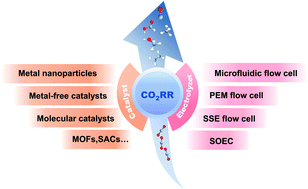Development of catalysts and electrolyzers toward industrial-scale CO2 electroreduction
Abstract
The electrochemical CO2 reduction reaction (CO2RR) has attracted significant research interest in recent years due to its potential to mitigate carbon emissions while providing valuable fuels and chemicals. The performance of the CO2RR has been improved from tens of milliamperes per square centimeter to orders of magnitude higher, with selectivity approaching 100% for some products. This review will highlight the key development of the CO2RR toward industrially relevant performance. We will first discuss the recent advances of electrocatalysts in refining the product's selectivity. A few representative electrocatalysts will be showcased, including metal-free catalysts, metal nanoparticles, and molecular catalysts and their derivatives. Then we will show the development of electrochemical cells for the CO2RR, which play a pivotal role in achieving a current density of amperes per square centimeter. Specifically, using the flow electrolyzer has significantly improved the CO2RR current densities compared to the conventional H-type cell. Lastly, we will provide perspectives on future development and challenges of the CO2RR.

- This article is part of the themed collection: Journal of Materials Chemistry A Emerging Investigators


 Please wait while we load your content...
Please wait while we load your content...